- Home
- Victor Hugo
Hunchback of Notre Dame (Barnes & Noble Classics Series)
Hunchback of Notre Dame (Barnes & Noble Classics Series) Read online
Table of Contents
From the Pages of The Hunchback of Notre Dame
Title Page
Copyright Page
Victor Hugo
The World of Victor Hugo and The Hunchbach of Notre Dame
Introduction
Preface
BOOK ONE
CHAPTER I - The Great Hall
CHAPTER II - Pierre Gringoire
CHAPTER III - The Cardinal
CHAPTER IV - Master Jacques Coppenole
CHAPTER V - Quasimodo
CHAPTER VI - Esmeralda
BOOK TWO
CHAPTER I - From Charybdis to Scylla
CHAPTER II - The Place de Grève
CHAPTER III - Besos Para Golpes
CHAPTER IV - The Inconveniences of Following a Pretty Woman in the Street at Night
CHAPTER V - The Continuation of the Inconveniences
CHAPTER VI - The Broken Pitcher
CHAPTER VII - A Wedding Night
BOOK THREE
CHAPTER I - Notre-Dame
CHAPTER II - A Bird‘s-Eye View of Paris
BOOK FOUR
CHAPTER I - Kind Souls
CHAPTER II - Claude Frollo
CHAPTER III - Immanis Pecoris Custos, Immanior Ipse
CHAPTER IV - The Dog and His Master
CHAPTER V - More about Claude Frollo
CHAPTER VI - Unpopularity
BOOK V
CHAPTER I - Abbas Beati Martini
CHAPTER II - The One Will Kill the Other
BOOK SIX
CHAPTER I - An Impartial Glance at the Ancient Magistracy
CHAPTER II - The Rat-Hole
CHAPTER III - The Story of a Wheaten Cake
CHAPTER IV - A Tear for a Drop of Water
CHAPTER V - End of the Story of the Cake
BOOK SEVEN
CHAPTER I - On the Danger of Confiding a Secret to a Goat
CHAPTER II - Showing that a Priest and a Philosopher Are Two Very Different Persons
CHAPTER III - The Bells
CHAPTER IV - ’Anátkh
CHAPTER V - The Two Men Dressed in Black
CHAPTER VI - The Effect Produced by Seven Oaths in the Public Square
CHAPTER VII - The Spectre Monk
CHAPTER VIII - The Advantage of Windows Overlooking the River
BOOK EIGHT
CHAPTER I - The Crown Piece Changed to a Dry Leaf
CHAPTER II - Continuation of the Crown Piece Changed to a Dry Leaf
CHAPTER III - End of the Crown Piece Changed to a Dry Leaf
CHAPTER IV - Lasciate Ogni Speranza
CHAPTER V - The Mother
CHAPTER VI - Three Men’s Hearts, Differently Constituted
BOOK NINE
CHAPTER I - Delirium
CHAPTER II - Deformed, Blind, Lame
CHAPTER III - Deaf
CHAPTER IV - Earthenware and Crystal
CHAPTER V - The Key to the Porte-Rouge
CHAPTER VI - The Key to the Porte-Rouge (continued)
BOOK TEN
CHAPTER I - Gringoire Has Several Capital Ideas in Succession in the Rue des Bernardins
CHAPTER II - Turn Vagabond!
CHAPTER III - Joy Forever!
CHAPTER IV - An Awkward Friend
CHAPTER V - The Retreat Where Louis of France Says His Prayers
CHAPTER VI - “The Chive in the Cly”
CHAPTER VII - Châteaupers to the Rescue
BOOK ELEVEN
CHAPTER I - The Little Shoe
CHAPTER II - La Creatura Bella Bianco Vestita
CHAPTER III - Marriage of Phœbus
CHAPTER IV - Marriage of Quasimodo
AUTHOR’S NOTE
Endnotes
Inspired by The Hunchback of Notre Dame
Comments & Questions
For Further Reading
From the Pages of
The Hunchback of Notre Dame
Upon this barrow rode resplendent, with crosier, cope, and miter, the new Pope of Fools, the bell-ringer of Notre-Dame, Quasimodo the Hunchback. (page 66)
The trunk of the tree is fixed; the foliage is variable. (page 111)
Say if you know of anything on earth richer, more joyous, more mellow, more enchanting than this tumult of bells and chimes; than this furnace of music; than these ten thousand brazen voices singing together through stone flutes three hundred feet in length; than this city which is but an orchestra; than this symphony which roars like a tempest. (page 134)
“This foundling, as they call it, is a regular monster of abomination.” (page 136)
The poor little imp had a wart over his left eye, his head was buried between his shoulders, his spine was curved, his breastbone prominent, his legs crooked; but he seemed lively; and although it was impossible to say in what language he babbled, his cries proclaimed a certain amount of health and vigor. (page 142)
It was Quasimodo, bound, corded, tied, garotted, and well guarded. The squad of men who had him in charge were assisted by the captain of the watch in person, wearing the arms of France embroidered on his breast, and the city arms on his back. (page 188)
“Come and see, gentlemen and ladies! They are going straightway to flog Master Quasimodo, the bell-ringer of my brother the archdeacon of Josas, a strange specimen of Oriental architecture, with a dome for his back and twisted columns for legs.” (page 219)
The people, particularly in the Middle Ages, were to society what the child is to a family. So long as they remain in their primitive condition of ignorance, of moral and intellectual nonage, it may be said of that as of a child,—
“It is an age without pity.”
(pages 220-221)
“A man must live; and the finest Alexandrine verses are not such good eating as a bit of Brie cheese.” (page 244)
The cathedral seemed somber, and given over to silence; for festivals and funerals there was still the simple tolling, dry and bare, such as the ritual required, and nothing more; of the double noise which a church sends forth, from its organ within and its bells without, only the organ remained. It seemed as if there were no musician left in the belfry towers. (pages 249-250)
Lovers’ talk is very commonplace. It is a perpetual “I love you.” A very bare and very insipid phrase to an indifferent ear, unless adorned with a few grace-notes; but Claude was not an indifferent listener. (page 283)
It was but too truly Esmeralda. Upon this last round of the ladder of opprobrium and misfortune she was still beautiful; her large black eyes looked larger than ever from the thinness of her cheeks; her livid profile was pure and sublime. (page 333)
“A drop of water and a little pity are more than my whole life can ever repay.” (page 357)
The heart of man cannot long remain at any extreme. (page 357)
“Fate has delivered us over to each other. Your life is in my hands; my soul rests in yours. Beyond this place and this night all is dark.”
(page 452)
Published by Barnes & Noble Books
122 Fifth Avenue
New York, NY 10011
www.barnesandnoble.com/classics
Victor Hugo first published Notre-Dame de Paris in 1831; the present anonymous translation was contemporaneous with the French edition.
Originally published in mass market format in 2004 by Barnes & Noble Classics with new Introduction, Notes, Biography, Chronology, Inspired By, Comments & Questions, and For Further Reading. This trade paperback edition published in 2008.
Introduction, Notes, and For Further Reading
Copyright © 2004 by Isabel Roche.
Note on The Hunch
back of Notre Dame, The World of Victor Hugo
and The Hunchback of Notre Dame, Inspired by The Hunchback of
Notre Dame, and Comments & Questions
Copyright © 2004 by Barnes & Noble, Inc.
All rights reserved. No part of this publication may be reproduced or transmitted in any form or by any means, electronic or mechanical, including photocopy, recording, or any information storage and retrieval system, without the prior written permission of the publisher.
Barnes & Noble Classics and the Barnes & Noble Classics colophon are trademarks of Barnes & Noble, Inc.
The Hunchback of Notre Dame
ISBN-13: 978-1-59308-140-9 ISBN-10: 1-59308-140-5
eISBN : 978-1-411-43235-2
LC Control Number 2007941529
Produced and published in conjunction with:
Fine Creative Media, Inc.
322 Eighth Avenue
New York, NY 10001
Michael J. Fine, President and Publisher
Printed in the United States of America
QM
1 3 5 7 9 10 8 6 4 2
FIRST PRINTING
Victor Hugo
Novelist, poet, dramatist, essayist, idealist politician, and leader of the French Romantic movement from 1830 on, Victor-Marie Hugo was born the youngest of three sons in Besançon, France, on February 26, 1802. Victor’s early childhood was turbulent: His father, Joseph-Léopold, traveled frequently as a general in Napoleon Bonaparte’s army, forcing the family to move throughout France, Italy, and Spain. Weary of this upheaval, Hugo’s wife, Sophie, separated from her husband and settled with her three sons in Paris. Victor’s brilliance declared itself early in the form of illustrations, plays, and nationally recognized verse. Against his mother’s wishes, the passionate young man fell in love and secretly became engaged to his neighbor, Adèle Foucher. Following the death of Sophie Hugo, and self-supporting thanks to a royal pension granted for his first book of odes, Hugo wed Adèle in 1822.
In the 1820s and 30s, Hugo came into his own as a writer and figurehead of the new Romanticism, a movement that sought to liberate literature from its stultifying classical influences. His preface to the play Cromwell, in 1827, proclaimed a new aesthetics inspired by Shakespeare and Velazquez, based on the shock effects of juxtaposing the grotesque with the sublime (for example, the deformed hunchback inhabiting the magnificent cathedral of Notre Dame). The play Hernani incited violent public disturbances among scandalized audiences in 1830. The next year, the great success of Notre-Dame de Paris (The Hunchback of Notre Dame) confirmed Hugo’s primacy among the Romantics.
By 1830 the Hugos had four children. Exhausted from her pregnancies and Hugo’s insatiable sexual demands, Adèle began to sleep alone, and soon fell in love with Hugo’s best friend, the critic Charles-Augustin Sainte-Beuve. They began an affair. The Hugos stayed together as friends, and in 1833 Hugo met the actress Juliette Drouet, who would remain his primary mistress until her death fifty years later.
Personal tragedy pursued Hugo relentlessly. His jealous brother Eugène went permanently insane at Victor’s wedding to Adèle. Three of Victor’s children died before him. His favorite, Léopoldine, together with her unborn child and her devoted husband, died at nineteen in a boating accident on the Seine. The one survivor, Adèle (named after her mother), would be institutionalized for more than thirty years.
Hugo’s early royalist sympathies shifted toward liberalism during the late 1820s under the influences of the fiery liberal priest Félic ite de Lamennais; of his close friend Charles Nodier, an ardent opponent of capital punishment; and of his father, a general under Napoleon I. He first held political office in 1843, and as he became more engaged in France’s social troubles, he was elected to the Constitutional Assembly following the February Revolution of 1848. A lifetime advocate of freedom and justice, often at his own peril, Hugo’s work linked art to the political realm. After Napoleon III’s coup detat in 1851, Hugo’s open opposition created hostilities that ended in his flight abroad from the new government.
Hugo’s exile took him first to Belgium, and then to the Channel Islands of Jersey and Guernsey. Declining at least two offers of amnesty—which would have meant curtailing his opposition to the Empire—Hugo remained abroad for nineteen years, until Napoleon’s fall in 1870. Meanwhile, the seclusion of the islands enabled Hugo to write some of his most famous verse and his masterpiece, the novel Les Misérables. When he returned to Paris, the country hailed him as a hero. Hugo then weathered, within a brief period, the siege of Paris, the institutionalization of his daughter for insanity, and the death of his two sons. Despite this personal anguish, the aging author remained committed to political change. He became an internationally revered figure who helped to preserve and shape the Third Republic and democracy in France. Hugo’s death on May 22, 1885, generated intense national mourning; more than two million people joined his funeral procession in Paris from the Arc de Triomphe to the Pantheon, where he was buried.
The World of Victor Hugo and
The Hunchbach of Notre Dame
1797 Hugo’s parents, Joseph-Léopold Hugo and Sophie Trébuchet, marry. They will have three sons: Abel (1798), Eugène (1800), and Victor-Marie (1802), who is born in Be sançon on February 26. An officer in the army of Napoleon Bonaparte (Napoleon I), Léopold must travel constantly during Victor’s youth.
1803 1812 Marital problems occur as Sophie cannot tolerate the tran sience of army life; finally, she settles in Paris with her three children. Both parents start extramarital affairs. The family travels to Corsica and Elba, where Léopold is stationed. He later commands the troops that will suppress freedom fight ers in occupied Italy and Spain, sometimes nailing their severed heads above church doors.
1804 apoléon proclaims himself Emperor of the French. Liter ary critic Charles-Augustin Sainte-Beuve is born.
1807 Leopold Hugo receives a post in Naples, where his family soon joins him.
1808 Leopold Hugo follows a cortege of Napoléon’s brother, Joseph, to Spain. Weary of travel, Sophie returns with her young sons to Paris, where she begins an affair with General Victor Lahorie, a conspirator against Napoleon.
1809 Napoleon promotes Major Hugo to general, and honors him with the title of count.
1810 The police arrest Lahorie in Mme. Hugo’s house on De cember 30.
1811 Sophie journeys to Spain to save her marriage, but problems in the relationship persist. Léopold, knowing of his wife’s in fidelity, asks for a divorce. Sophie and her sons return to Paris.
1812 General Lahorie is executed for plotting against Napoleon.
1814 Napoléon abdicates and is banished to the island of Elba. The monarchy is reinstated, and Louis XVIII is named king.
1815 Napoleon returns from exile. The “Hundred Days” of his re newed reign ends when he is defeated at Waterloo. Louis XVIII returns to power.
1816 A marvelously gifted and precocious writer, Victor Hugo pro claims his ambition to rival François-René de Chateaubriand, the most famous Romantic author of his generation. Es tranged from his father and influenced by his mother, a roy alist by expediency, he skillfully curries favor with the conservative literary establishment and the King, whom he praises in odes.
1817 Hugo wins honorable mention in the national poetry con test sponsored by l‘Académie française (the French Acad emy).
1818 Sophie and Léopold are legally separated (divorce was ille gal in France between 1816 and 1886). Victor composes a first, brief version of his novel Bug-Jargal, an account of a slave revolt in the Caribbean after the French Revolution; this version will appear in 1820.
1819 Despite his mother’s wishes for a more ambitious union, Victor falls in love with—and secretly asks the hand of—his neighbor, Adèle Foucher. But as a minor, he cannot marry her without his mother’s consent, which is denied. The three Hugo brothers found a literary journal called Le Con servateur littéraire.
1820 1821 Hugo writes over one hundred essays and more than tw
enty poems for Le Conservateur.
1821 Victor becomes friends with the famous priest Félicité de Lamennais, who preaches a socially committed Christianity. Victor’s mother dies on June 27. In July his father marries his mistress, Catherine Thomas. Victor becomes reconciled with his father, who does not oppose Victor’s marriage to Adèle.
1822 Granted a small pension by Louis XVIII for his first volume of Odes praising the monarchy, Victor marries Adèle Foucher on October 12. Eugène Hugo, who also loves her, has a psychotic breakdown at the wedding; he will never re cover.
1823 Hugo publishes a pioneering historical novel, Han d’Islande (Han of Iceland, sometimes translated as The Demon Dwarf), a bloodthirsty melodrama. He helps found the periodical La Muse frangaise and attends weekly gatherings hosted by the then leader of the French Romantic movement, Charles Nodier (1780-1844).
1824 Hugo publishes the Nouvelles Odes. His first child, a daugh ter, Léopoldine, is born. Charles X assumes the throne, and Victor serves as the historian of the coronation.
1826 Odes et Ballades is published, as is the full version of BugJargal, noteworthy for its altruistic black hero. Adèle gives birth to Hugo’s second child, Charles-Victor.
1827 Hugo becomes best friends with the critic Sainte-Beuve. The play Cromwell is published; its famous preface proposes a Romantic aesthetic that contrasts the sublime with the grotesque, in emulation of Shakespeare. Hugo declares his independence from the conservative, divine-right royalists.

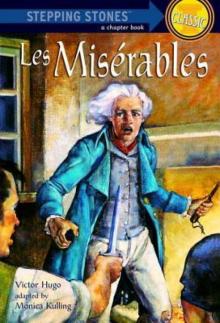 Les Miserables
Les Miserables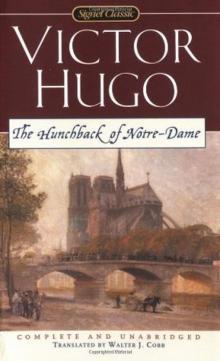 The Hunchback of Notre-Dame
The Hunchback of Notre-Dame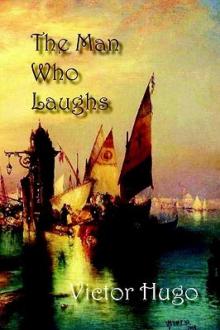 The Man Who Laughs
The Man Who Laughs The Last Day of a Condemned Man
The Last Day of a Condemned Man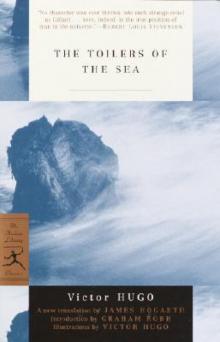 The Toilers of the Sea
The Toilers of the Sea Waterloo
Waterloo Les Misérables, v. 1/5: Fantine
Les Misérables, v. 1/5: Fantine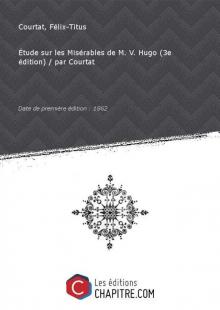 Les Misérables, v. 3/5: Marius
Les Misérables, v. 3/5: Marius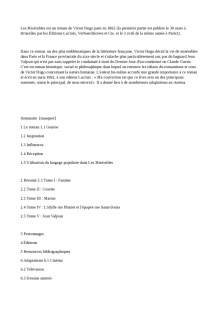 Les Misérables, v. 2/5: Cosette
Les Misérables, v. 2/5: Cosette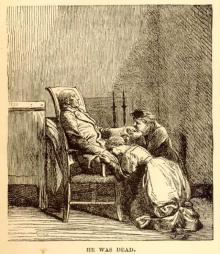 Les Misérables, v. 5/5: Jean Valjean
Les Misérables, v. 5/5: Jean Valjean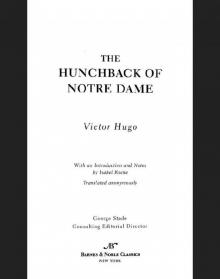 Hunchback of Notre Dame (Barnes & Noble Classics Series)
Hunchback of Notre Dame (Barnes & Noble Classics Series)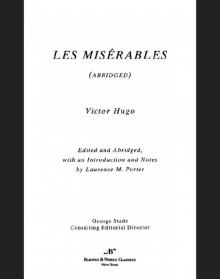 Les Miserables (abridged) (Barnes & Noble Classics Series)
Les Miserables (abridged) (Barnes & Noble Classics Series)